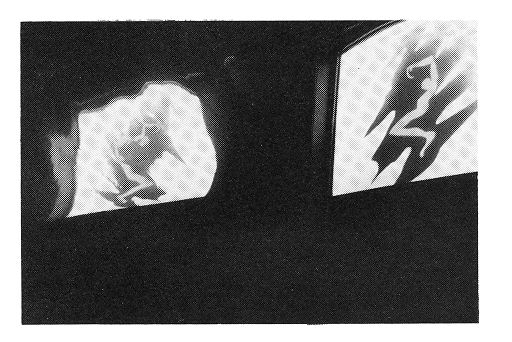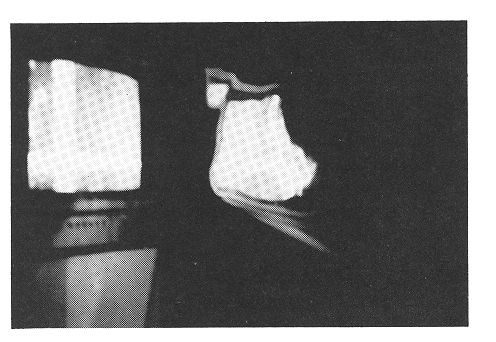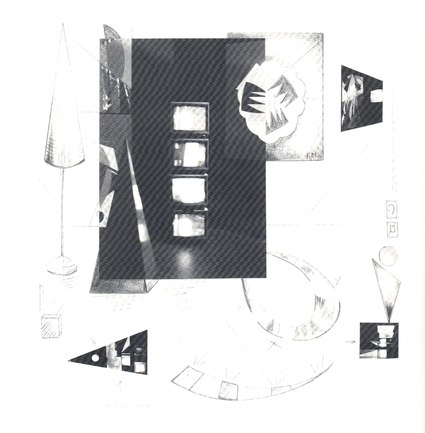Cyclone
One's first impression on entering Parácas Chimu is a feeling of disorientation. In a brief period of time, one is exposed to a deluge of impressions succeeding each other at high speed. In a dark room are monitors, paintings and sculptures. The monitors form a column, stand in a row, or occupy isolated positions in the room. They are fed by three different tapes played synchronously. Eleven paintings are hung here and there on the black walls. They are conspicuous for there special language of form and their bold colors. The forms of the sculptures suggest that they had just stepped out of the paintings - only very much enlarged. Three geometric mirrors mounted on the walls reflect the colorful spectacle. Sounds of a sound-collage fill the room.
Sedimentation
When the first impressions have been assimilated, one realizes that Parácas Chimu is a very coherent and well-considered work of art. The images of the three tapes, succeeding each other at an incredible speed, are composed of abstract as well as familiar elements. MAATS manipulates the visual material in various ways. Recognizable elements such as the image of the dancer, photographic quotations from art history, and images of a control system are used as the building materials for an abstract visual composition, which is achieved by making playful cut-outs, and combining these in new ways. The abstract fragments from FRITS MAATS' paintings are metamorphosed by means of the same techniques. Two paintings that are present in the room provide the starting point for this process.
Sometimes MAATS manipulates the image more brusquely, by a rough stroke of the paintbrush. These image manipulations are interspersed with monochrome and geometric fragments of simple design.
Contrasts
The use of color in the tapes agrees well with the colors of the paintings: quiet, earthly colors contrasting with bright, exuberant ones. The name of the installation, Parácas Chimu, is a Peruvian expression referring to the impressionistic and expressionistic colors used by the Indians to paint their clothes.
The video images with their varying use of colors and tempo evoke several different moods, from violent or gloomy to serene or light-footed. The sound creates similar effects, but does not always stick to the images; sometimes sound and image are in harmony, then again they contrast with each other.
The paintings do not only relate to the medium video within the tapes, but also in other respects. The colored light of the monitors is cast on the paintings directly or by reflection, and is continually transforming them. Colors from pigment and from the screen interact and modulate each other, with surprising effects.
In this context the mirrors and a centrally placed sculpture with a reflecting surface suggest works of art capable to change their shape continually. The other sculptures are merely subordinated to the tapes.
Typical forms
An important connecting element is MAATS' approach to form, which is in evidence everywhere: in the paintings as well as in the cut-outs from the tapes, and also in the way the pedestals of the monitors, the mirrors and the sculptures have been designed. Clear-cut, geometric, and polished, fluent forms are used as elements of a composition or as decoration. This is also true for the stylized figurative elements that can be found everywhere in Parácas Chimu .
The painting as a semi-manufactured article?
According to FRITS MAATS, he approaches the medium video as a painter and a sculptor. When he was still exploring the possibilities of the medium in 1982, he made a tape History and Impotence. In this tape, in a very short time, a book on art history was leafed through from the beginnings of art to the present, accompanied by up-tempo music. The question MAATS asked himself in this tape was: What can the present-day artist contribute to existing art?
MAATS has made a contribution to his own art by his approach to video. In tapes like Hridaya (1985) en Karnak (1986), he added the dimension of time to the paintings, and demonstrated the pictorial qualities of video. In Hridaya , he manipulated the painting by means of videographic techniques; the video images were manipulated by means of traditional painting techniques. In the tape, for example, parts of the painting are taken out and reproduced, forming a new image, which is again metamorphosed by a simple stroke of the paintbrush. The approach in Karnak differs from Hridaya, because in Karnak MAATS uses not only cut-outs, but also other forms of image manipulation, more suggestive of video-synthesizing. The dancer, who appears frequently on the screen, is like a monochromatic spectre, trailing behind her ever-changing, flowing colors.
For the tapes in Parácas Chimu, MAATS has used much the same approach as in Hridaya and Karnak. In Parácas Chimu he has not, however, restricted himself to the video tape as a means of making video and painting merge with each other. The room is used as an extra dimension, adding another aspect to the encounter of video art and painting. In Parácas Chimu therefore, the borderlines between the different media have been crossed, and an art form of a wholly different nature has been created.
If you'd like to quote something: Rajandream, Marie-Adèle. "Parácas Chimu." Mediamatic Magazine vol. 1 # 4 (1987).
Translation: Fokke Sluiter


